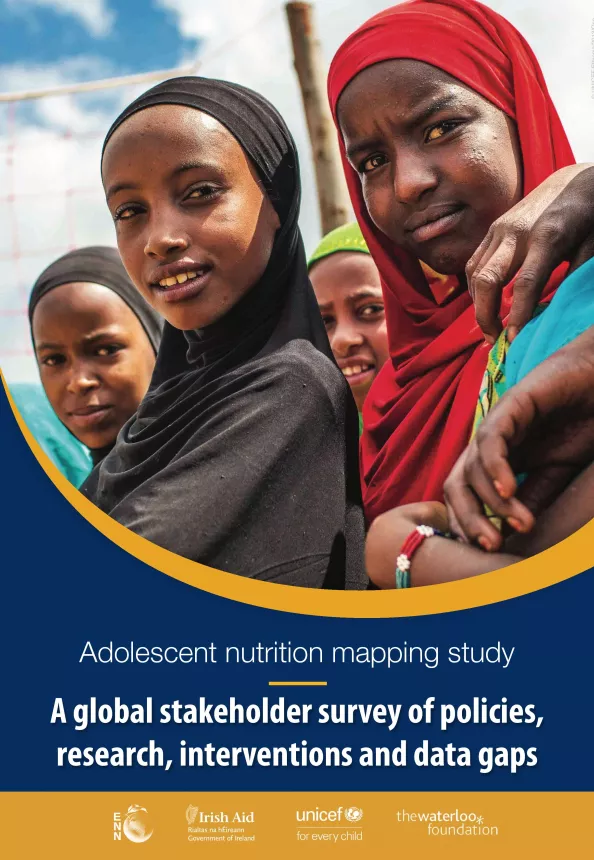Adolescent nutrition mapping study: A global stakeholder survey of policies, research, interventions and data gaps
Publication details
Executive Summary
Nutrition in school-aged children and adolescents can significantly impact lifelong health and wellbeing as well as national economic growth and the health and development of future generations. There is currently a lack of information and/or consensus on the burden and long-term effects of malnutrition in adolescents, the metrics and indicators needed to define and prioritise nutritional deficits, adequacy and improvements and successful interventions to tackle adolescent malnutrition.
To map ongoing activities and experiences, we undertook a survey of stakeholders. The survey had three main sections, 1) research and data, 2) policies, strategies and guidelines on adolescent nutrition and 3) interventions and programmes targeting adolescents. Nutrition outcomes of interest were categorised as micronutrient status, undernutrition (including wasting, thinness and stunting), overweight and obesity and dietary behaviours or practices. The analysis included 133 responses with representation from across 42 countries covering seven United Nations International Children’s Fund (UNICEF) global regions. Most respondents reported that their work focuses on low- and middle-income countries (LMICs) across Africa and Asia.
The results identified that research on adolescent nutrition has mainly focused on burden while indicators and consequences of malnutrition have received less attention. Micronutrient deficiencies, diets and undernutrition have been the focus of most studies with adolescent overweight and obesity receiving less attention. Policies targeting adolescents are available at international, regional and national levels and come from a range of sectors. Most adolescent nutrition programmes and interventions are provided through health, nutrition and education sectors with support from United Nations (UN) agencies and non-governmental organisations (NGOs). Many of the successful and large-scale adolescent nutrition programmes described by the respondents focus on micronutrient deficiencies, especially anaemia reduction through weekly iron and folate distributions. Other large-scale programmes include social media campaigns and school-based peer education programmes to influence diet choices.
The survey identified that a wide variety of definitions are being used for the adolescent period and, in some contexts, no definition is available at all. This lack of agreement creates difficulties in providing representative and comparable data on adolescents across the world. Data that does exist often cannot be compared because of differences between the age groups studied or how age groups are disaggregated. Differences between the reference populations used to define malnutrition further limit comparability. Thus, it would be helpful for organisations and national governments to adopt a universal definition of adolescence.
The lack of an agreed upon definition for adolescence may be acting as an important barrier to establishing national and international adolescent nutrition targets. In addition, there are a number of other important data and policy gaps for adolescent nutrition that need to be addressed including standardised anthropometric definitions of malnutrition in adolescents and school-age children, particularly those feasible for use in emergency contexts, data on current and optimal diets, the inclusion and/or disaggregation of adolescent data within national surveys, data on sub-groups within adolescence (e.g., males, refugees, out-of-school adolescents), evidence on effective interventions to reach adolescents, adolescent voices within research, adolescent-specific targets, nationally and internationally, the inclusion of adolescents within national health and nutrition policies and designated research funding for this age group.
Lastly, our results suggest that, among this group of stakeholders (largely working in LMICs in Africa and Asia), overweight and obesity research, policies and programming efforts are the least represented areas of adolescent malnutrition. This is a worrying omission considering the rising tide of overnutrition and obesity across all age groups and the lifelong adverse consequences that can result.
Recommendations
- It would be helpful if a universal definition of adolescence could be adopted as this would facilitate the setting of global targets and allow comparison across research and programmes. To date, the most commonly used definition is 10-19 years.
- In order to focus efforts to tackle adolescent malnutrition, adolescent-specific nutrition targets are needed, nationally and internationally. These should go beyond anaemia in women of reproductive age.
- To guide programming, routine national surveys, such as demographic and health surveys and multiple indicator cluster surveys, should be age-disaggregated to represent the adolescent population.
- In order to improve adolescent nutrition, health and wellbeing, more research and agreement is required on:
- Effective interventions, particularly for dietary patterns and overweight/obesity
- The nutritional needs of subgroups including male adolescents, those out-of-school and adolescents in humanitarian contexts
- The most useful indicators to identify and classify malnutrition
- How best to reach adolescents, for example utilising new opportunities via social media platforms
- Greater attention to, and funding from, donor agencies is required to address the research and programmatic gaps identified in this review and to ultimately improve adolescent outcomes.
